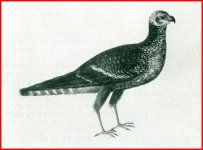"Any opinion on the type of Polyborus?"
The type is Polyborus vulgaris from Vieillot ? Because of Art 70.3?
http://www.archive.org/stream/nouveaudictionna05metc#page/257/mode/1up .
The gardens and menagerie of the Zoological Society delineated, Volume 2
By Edward Turner Bennett. (1831)
“Marcgrave was the first to introduce into Europe the name of Caracara, the vulgar appellation of the bird in Brasil, derived from its hoarse and peculiar cry. But although M. Cuvier regards Marcgrave’s Caracara as identical with our own, both the figure and description are so much at variance with the latter, that we feel ourselves compelled to adopt in preference the opinion of Professor Lichenstein, founded upon the original drawing, that they belong to a totally different bird.”
http://books.google.com/books?id=t0...ions:OCLC7471753#v=onepage&q=Caracara&f=false . Page 299.
Marcgrave’s watercolors and oils? or painted by someone else? under his direction? were at Lichenstein’s museum.
They were published in 1995 FERRÃO, C. & SOARES, J.P.M. (Eds.), 1995a. Brasil Holandês, T.2, Libri Principis. Rio de Janeiro: Editora Index, vol.1, 192p. There is a Vol. 2 also. It might behoove someone to look at these for a Caracara.
Die Werke von Marcgrave und Piso über Naturgeschichte Brasiliens, etc. von Herrn. Lichtenstein
Cap. XII. P. 211.
Caracara ist Falco brasiliensis Gm., eine freilich durchaus räthselhafte, ganz allein auf dieser Stelle bei Marcgrave beruhende Species, von der ich nur bemerken will, daß sie nach der Abbildung (L.P. II. p. 212) am nächsten mit unserm Falco rufus verwandt ist.
http://books.google.com/books?id=mO...siliens&client=firefox-a#v=onepage&q=&f=false .
Cap. XII. P. 211
Caracara Falco brasiliensis is Gm., A mysterious well of course, wants all alone on this point at Marcgrave based species, of which I only noticed that she is related to the figure (LP, II, p. 212) with our closest rufus Falco . (Google translation)
THE BIRDS OF THE REPUBLIC OF PANAMA, Part 1. By ALEXANDER WETMORE: (1965)
CARACARA PLANCUS (Miller): Caracara; Carancho
Falco Plancus J. F. Miller, Var. Subj. Nat. Hist., pt. 3, 1777, pl. 17. (Tierra del Fuego.)
The generic name Caracara used here follows acceptance of this name in the last edition of the A.O.U. Check-list of North American Birds (1957, p. 116). Polyborus proposed in 1816 by Vieillot (Anal. Nouv. Orn. filem., p. 22) with "Caracara, Buff.," which is Falco
brasiliensis Gmelin, as its only species and therefore its type, was long the accepted genus for the caracaras. Buffon's name "Caracara" is based on a bird described by Marcgrave in his Historia Natural do Brasil published in 1648, with an illustration in the stilted form com- mon in works on natural history of that period. In a study of the original paintings from which the figure was reproduced Adolf Schneider (Journ. Orn., 1938, pp. 93-94, fig. 3) found that the Caracara of Marcgrave actually is the harrier known currently as Circus buffoni (Gmelin). The generic name Polyborus, 1816, thus
becomes a synonym of Circus Lacepede, 1799. The next available name for the group formerly called Polyborus is Caracara Merrem (in Ersch u. Gruber, Allg. Encycl. Wiss. Kiinste, vol. 15, 1826, p. 159). Amadon (Auk, 1954, pp. 203-204) has cited a personal communica- tion from Stresemann who "would prefer to declare the drawing as unidentifiable" in order to avoid this change. But examination of the figure reproduced by Schneider shows definitely that it is a harrier. While the drawing, like most of its day, is crude, the evident ruff on the side of the small head clearly indicates a harrier, and the barring on the under tail coverts is characteristic of Circus buffoni. This species ranges widely in northern and eastern South America from Colombia, Venezuela, and Trinidad to central Chile, Argentina, and much of Brazil. Specimens are recorded from Para and from Espiritu Santo to the north and south of the area where Marcgrave traveled, a point that Stresemann seems to have overlooked in his comment that no harrier had been recorded from the region concerned. There seems to be no reason to reject the identification.
Make up a new name and type?
http://www.mapress.com/zootaxa/2009/f/z02013p016f.pdf .
http://acd.ufrj.br/~museuhp/CP/Bol-Zool/BolZool2006/Bol Zool MN 523.pdf .
Amadon
On the Correct Names for the Caracaras and for the Long-winged Harrier.
http://elibrary.unm.edu/sora/Auk/v071n02/p0203-p0204.pdf .
The name Falco brasiliensis Omelin 1788 and the genus Polyborus Vieillot both
have as their type a miniature colored drawing by Marcgrave
Falco brasiliensis Gmelin, Syst. Nat., 1, (1), p. 262, 1788 — based on (Brisson ex) Marcgrave's "Caracara," Hist. Nat. Bras., p. 211, northeastern Brazil; hab.
subst. Pernambuco
Lesson 1828 has Caracara as a genus:
http://books.google.com/books?id=KY...&ved=0CBsQ6AEwCA#v=onepage&q=Caracara&f=false .





